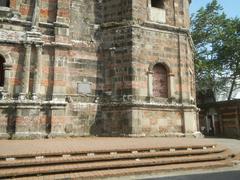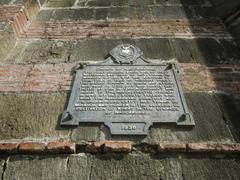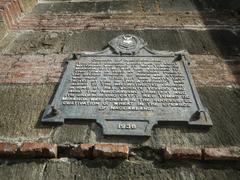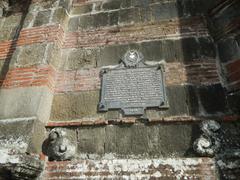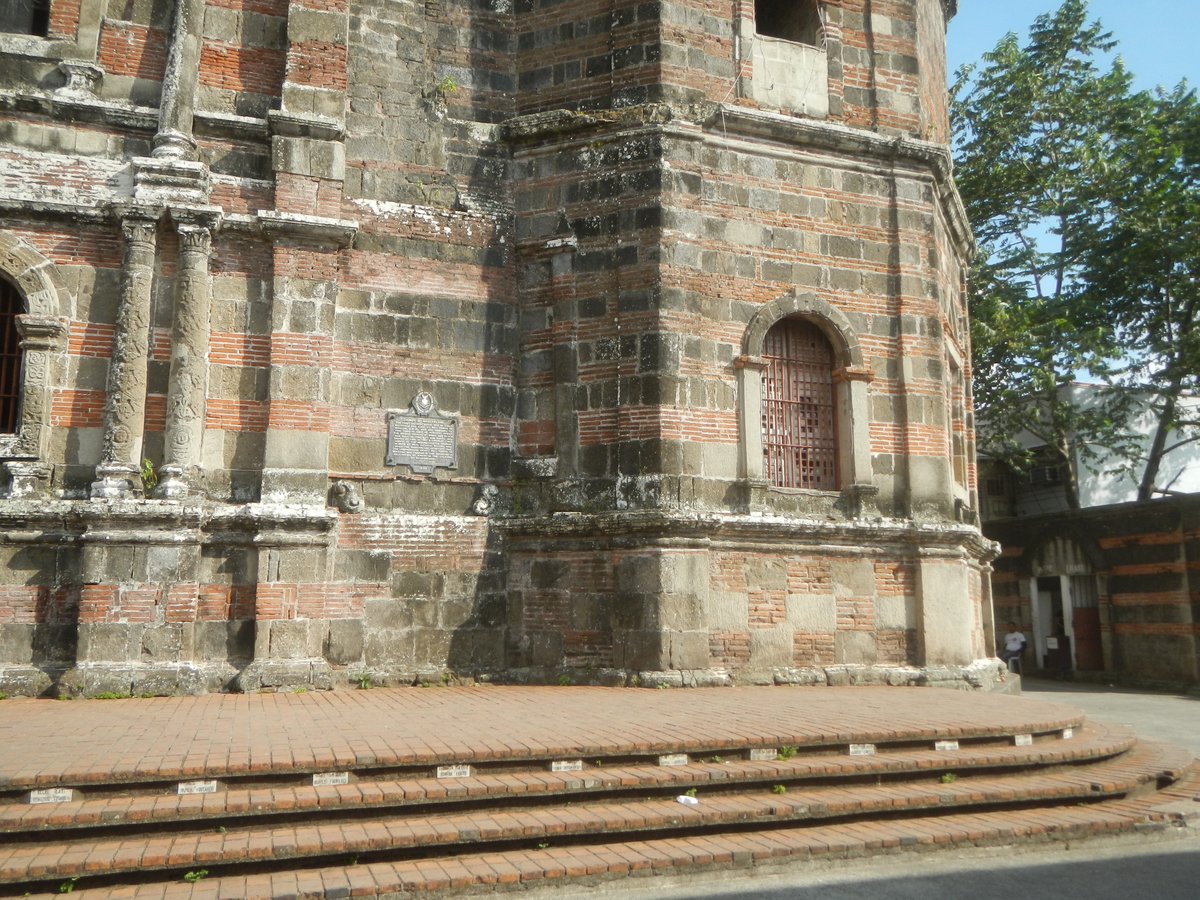
Visiting the Church of Nagcarlan Historical Marker, Nagcarlan, Philippines: Tickets, Hours, and Tips
Date: 14/06/2025
Introduction: History and Significance of the Church of Nagcarlan
Nestled in Laguna, the Church of Nagcarlan—officially San Bartolome Apostol Parish Church—stands as a lasting emblem of Spanish colonial heritage, Catholic faith, and community resilience in the Philippines. Established in 1578 by Franciscan missionaries, the church’s evolution from a simple nipa and bamboo structure to a grand Baroque edifice mirrors the region’s historical journey. Its storied walls have witnessed not only religious rites but also clandestine revolutionary gatherings, making it a central figure in both spiritual and national narratives (National Historical Commission of the Philippines; Laguna Travel Guide).
Complementing the church is the nearby Nagcarlan Underground Cemetery—the country’s only subterranean burial site—which further enriches the area’s historical and architectural distinctiveness (NHCP; Pinoy Builders). This guide delves into the church’s layered past, architectural features, and modern-day visitor experience, providing practical advice on hours, tickets, tours, and accessibility. Whether you’re a heritage enthusiast, pilgrim, or traveler, you’ll find comprehensive insights for planning a meaningful visit (Wikipedia; Nagcarlan LGU).
Table of Contents
- Early Foundations of the Nagcarlan Church
- Architectural Evolution and Features
- Role in Spanish Colonial and Revolutionary History
- The Nagcarlan Underground Cemetery Connection
- Visitor Information: Hours, Tickets, and Tours
- The Historical Marker: Installation and Purpose
- Restoration and Preservation Efforts
- Cultural and Religious Importance
- The Church in Contemporary Times
- FAQs
- Notable Events and Milestones
- Planning Your Visit
- Exploring More Heritage Sites
- Stay Connected
Early Foundations of the Nagcarlan Church
The origins of the church date to 1578, when Franciscan missionaries, including Fray Juan de Plasencia and Fray Diego de Oropesa, established a mission in Nagcarlan. The first church, built with nipa and bamboo, symbolized early evangelization efforts and adaptation to local resources (National Historical Commission of the Philippines). By 1752, the church was reconstructed using stone and bricks under Fray Cristobal Torres, marking Nagcarlan’s rise as a religious and administrative center (Laguna Travel Guide).
Architectural Evolution and Features
Completed in 1845 under Fray Vicente Velloc, the present stone church is a prime example of Baroque architecture. Its façade is marked by robust buttresses, arched windows, and ornate detailing. Inside, an intricately carved retablo (altarpiece) and religious iconography grace the sanctuary (Philippine Churches). The bell tower, historically used as a lookout, is a prominent feature, while the adjoining convent reflects Spanish and local construction techniques with adobe and red brick, ensuring durability against time and natural disasters.
Role in Spanish Colonial and Revolutionary History
The church was pivotal in spreading Christianity and Spanish culture, centralizing sacraments, education, and community gatherings. It played a role in the colonial reduccion policy, bringing indigenous populations into organized towns (NHCP). During the Philippine Revolution, the church and its bell tower served as strategic sites for both colonial authorities and Filipino revolutionaries.
The Nagcarlan Underground Cemetery Connection
Located about 1.5 kilometers from the church, the Nagcarlan Underground Cemetery—built in 1845—serves as the only underground cemetery in the Philippines (National Historical Commission of the Philippines). Its octagonal chapel and subterranean crypts were reserved for friars and local elites, while the above-ground niches served the broader Catholic community. The cemetery was also a secret meeting place for revolutionaries during pivotal moments in Philippine history.
Visitor Information: Hours, Tickets, and Tours
Nagcarlan Church
- Hours: 7:00 AM to 6:00 PM daily
- Entrance Fee: Free (donations appreciated)
- Accessibility: Ramps provided; some historic areas may have limited access
- Guided Tours: Available through local heritage groups and the Nagcarlan LGU; advance arrangements recommended
Nagcarlan Underground Cemetery
- Hours: Tuesday to Sunday, 8:00 AM to 4:00 PM (closed Mondays)
- Entrance Fee: None, but donations are encouraged
- Guided Tours: Staff and caretakers provide historical background
Travel Tips
- Visit early in the morning or late afternoon for fewer crowds and optimal lighting
- Photography is allowed, but flash is prohibited during Mass and inside the cemetery crypt
- Dress modestly and respect ongoing religious services
Nearby, explore ancestral houses, Nagcarlan Plaza, and local markets for Laguna delicacies.
The Historical Marker: Installation and Purpose
Installed by the National Historical Commission of the Philippines, the bronze marker summarizes the church’s founding, architectural features, and historical importance (NHCP Markers). It serves both as an educational tool and as formal recognition of the site’s national significance, ensuring protection under heritage laws.
Restoration and Preservation Efforts
Multiple restorations have been undertaken to address damage from earthquakes and typhoons, with significant work in the 20th and 21st centuries led by the parish, Diocese of San Pablo, and heritage groups (Philippine Heritage Conservation Society). The designation as a National Historical Landmark has secured funding and legal protection for ongoing conservation.
Cultural and Religious Importance
The church is a vibrant religious center, especially during the August 24 feast of St. Bartholomew, which attracts thousands (Nagcarlan LGU). It hosts significant rites—baptisms, weddings, Holy Week processions—and serves as a hub for community traditions and local folklore.
The Church in Contemporary Times
Today, Nagcarlan Church is both an active place of worship and a major heritage destination (Department of Tourism). Heritage tours, educational trips, and sustainable tourism practices help balance its preservation with increasing visitor interest.
Frequently Asked Questions (FAQs)
Q: What are the visiting hours of Nagcarlan Church?
A: Open daily from 7:00 AM to 6:00 PM.
Q: Is there an entrance fee?
A: No, but donations are appreciated.
Q: Are guided tours available?
A: Yes, through local heritage groups or the LGU.
Q: Is the church accessible for persons with disabilities?
A: Ramps are provided; some historic areas may be less accessible.
Q: Can I take photos inside?
A: Yes, except during Mass or inside the cemetery’s crypt.
Q: What are nearby attractions?
A: Nagcarlan Underground Cemetery, ancestral houses, Nagcarlan Plaza.
Notable Events and Milestones
- 1578: Church founded by Franciscans
- 1752: Rebuilt in stone under Fray Cristobal Torres
- 1845: Present church and underground cemetery completed
- 1896-1898: Site for revolutionary activities
- 1973: Historical marker installed
- 2001–present: Ongoing conservation efforts
Further info: NHCP official website | Nagcarlan local government portal
Planning Your Visit
- Transport: Access via SLEX-Calamba, then provincial roads to San Pablo/Nagcarlan; buses from Manila to San Pablo, then jeepneys/tricycles.
- Facilities: Restrooms, gardens, benches, nearby food stalls.
- Dress Code: Modest attire recommended.
- Best Itinerary: Pair church visit with the Underground Cemetery and local heritage sites for a full-day experience.
Explore More Heritage Sites
Expand your Laguna itinerary with visits to San Pablo Cathedral, Liliw Church, Pagsanjan Church, and the Rizal Shrine.
Stay Connected
For updates on schedules, events, and preservation news, download the Audiala app and follow official social media channels.
Summary and Final Tips
The Church of Nagcarlan and its Underground Cemetery are living testaments to the Philippines’ colonial, religious, and revolutionary heritage. The Baroque church, historic marker, and unique underground cemetery provide a multidimensional experience that blends spiritual, architectural, and historical exploration. With no entrance fees, accessible facilities, and guided tours, visitors can immerse themselves in the rich narratives of Nagcarlan while supporting ongoing preservation efforts (NHCP Markers; Philippine Heritage Conservation Society; Audiala).
When visiting, observe site etiquette, plan your trip to include nearby attractions, and stay updated through official sources. By engaging thoughtfully with these sites, you help ensure their legacy for future generations (Department of Tourism; Nagcarlan LGU).
References and Further Reading
- National Historical Commission of the Philippines
- Laguna Travel Guide
- Philippine Churches
- Wikipedia: Nagcarlan Church
- Pinoy Churches
- Trek Zone
- Nagcarlan Underground Cemetery, NHCP
- Pinoy Builders
- Out of Town Blog
- Philippine Heritage Conservation Society
- Nagcarlan Local Government Unit
- Department of Tourism
- Audiala
